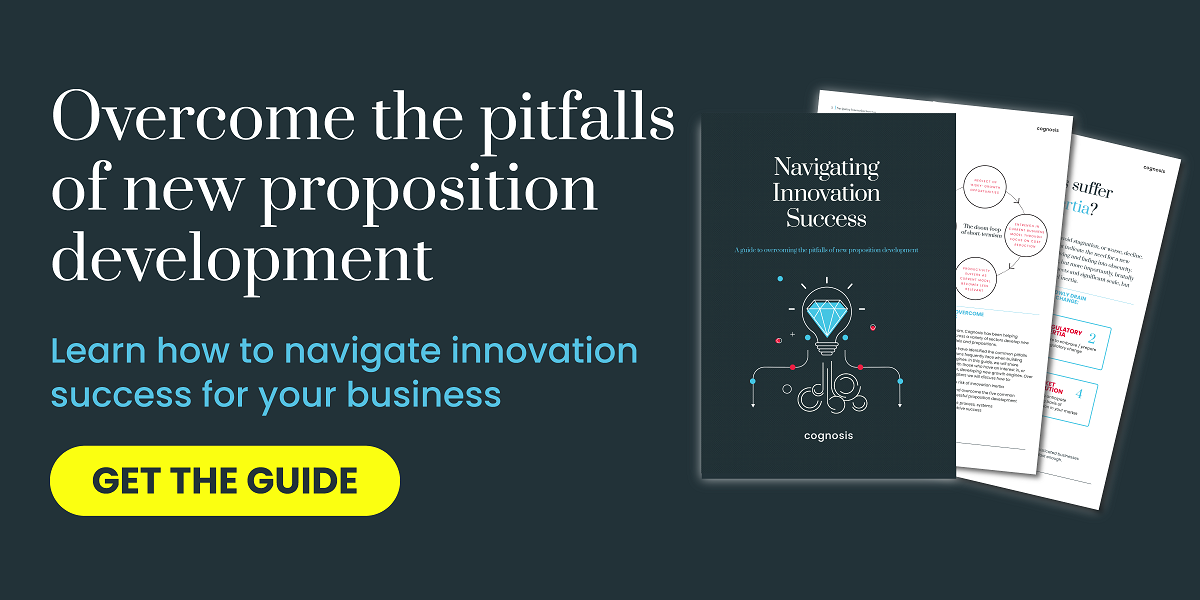The art of creating new value with proposition development
Growth-minded businesses have a plethora of ideas for developing new product and service lines, but that’s often the easy bit. How do you turn these ideas into a commercially successful proposition? Here are 5 key principles that underpin the successful development of new value propositions, products, services, and business model innovations so that you have confidence and conviction in what you are taking to market.

Growth-minded businesses harbour a wealth of ideas, brimming with potential for developing new products and services. These ideas serve as the seeds of growth, waiting to be nurtured into commercially successful propositions.
However, the ideation is often the easy bit and establishing new growth engines can be costly. It takes a robust development programme - a journey that demands tenacity, humility, a critical mindset, and, above all, an unwavering commitment to understanding the genuine needs of consumers. Our comprehensive approach is founded on 5 key principles that underpin the successful development of new value propositions, products, services, and business model innovations so that you have confidence and conviction in what you are taking to market.
> BUSINESS MODEL INNOVATION: The case for value proposition development
Principle 1: Get Everyone on the Same Page
One of the most significant challenges in any organisation is aligning the diverse perspectives of its members - it's a bit like trying to steer a ship when the crew members all have their own compasses pointing in different directions. We've witnessed numerous enterprises march forward with a particluar new offering, only to discover that key stakeholders hold fundamentally different views about the proposition under development.
To counteract this, the first step of any proposition development process is to craft a hypothesis articulated within a business model canvas. In simple terms this should include:
- A description of the new service or product and it's key features
- Clarity on the target consumer
- The key need we are fufilling
- An outline of the potential commercial model
- The capabilities and assets needed to develop and deliver the new offering
This hypothesis serves as a North Star in the proposition development process. It can be developed relatively quickly based on internal data, existing research, the views of key people in the business and a quick scan of competitor products or services.
What's even more crucial is that this canvas garners the engagement and approval of critical sponsors within the organisation. By doing so, you start on solid ground, with a united front ready to embark on the development journey.
Principle 2: Assess Desirability, Viability, and Feasibility Early
Imagine building a bridge without considering whether people will actually use it, whether it can support its intended traffic, or if you have the right materials and workers to construct it. Applying the Desirability, Viability, and Feasibility (DVF) model early in the process serves as a crucible, forcing you to challenge assumptions and address critical issues from the outset.
- Is this desirable? Do consumers/customers need this?
- Is this viable? Can we make money from this?
- Is this feasible? Do we have the capability to deliver this?
These questions might sound like common sense, but all too often, they are overlooked until it's too late. The DVF assessment allows you to define the key questions that need to be answered. The output data is then scored against a pre-defined scale. This enables a cross comparison of different ideas that helps to reveal what is a genuine opportunity or a potential risk. If a particular idea grades low, or enough people have doubts, then there’s no shame in mothballing that idea.
Principle 3: Regularly Question the Consumer's Desire
Developing a new proposition isn't a linear process. There are frequent forks and even U-turns in the road. To ensure you're headed in the right direction, it's crucial to set up 2-3 'go-no-go' sessions along the way. These sessions serve as checkpoints, encouraging the team to take a step back and ask the essential question:
"Do consumers still want this?"
To conduct these sessions effectively, you need a cross-functional team that openly scrutinises and challenges the current proposition/s alongside any new insights and feedback. While there is no need to re-run a DVF assessment at each 'go-no-go' stage you may have new insights that changes your view on how desirable, viable or feasible the proposition is. The critical outcome for each of these sessions is reaching an objective and aligned view on if it is worth investing more time, effort and resource to develop the idea further.
Let us remind you that concluding not to proceed is just as good an outcome as deciding to proceed.
Principle 4: Test and Iterate with Real Consumers
It's a common trap to fall into: assuming that your initial idea is the perfect one. However, in the real world, the path to success is filled with unexpected twists and turns. Once you have a clear picture of your value proposition, it's imperative to get it in front of real consumers and gather their feedback.
Another word of caution: Not all consumer feedback is gold, and overreacting to every critique can lead to unnecessary pivots. Instead, focus on multiple iterations and watch as your proposition evolves, taking shape through the invaluable insights and ideas that only consumers can provide.
Principle 5: Don't Neglect the Go-to-Market Plan
The ultimate litmus test is when you unleash your new offering to the market. Yet, this moment should not come as a surprise; it must be carefully planned. In our view, go-to-market planning should commence well before the proposition is fully nailed down.
Why? For one, it takes time to ensure that your offering can hit the market as soon as possible. Secondly, and just as critically, go-to-market planning often uncovers challenges related to viability and feasibility. The earlier you encounter these challenges, the greater your opportunity to address them, potentially saving your proposition from stumbling at the finish line.
A recent project in the food processing sector found that despite there being a really exciting viable opportunity; the go-to-market planning uncovered that the manufacturing of the new processing units had lead times up to 18 months longer than the client was expecting. This meant a significant re-work to the proposition in order to get it up and running within the timeframe required.
So why do these principles matter?
We all know the cautionary tales of Kodak, Nokia, Blackberry and Blockbuster. These are businesses that failed to adapt, failed to build desireable, feasible and viable business models for the future.
But take great inspiration from Disney, Orsted, Pepsico and many, many more. These are businesses that embrace these principles - they understand the need to evolve, adapt and continuously find new ways to delight consumers and customers.
Developing and launching successful new commerical propositions has a fair share of challenge that must be overcome. To navigate this path, you need a roadmap (we can help) based on the principles of alignment, early assessment, continuous reflection, consumer interaction, and vigilant planning to increase your chances of creating offerings that captivate consumers, drive revenue, and secure their place in the ever-evolving marketplace.
> DID YOU KNOW? Cognosis is proud to be named a Top UK Consulting Firm for Strategy and Innovation in 2023


